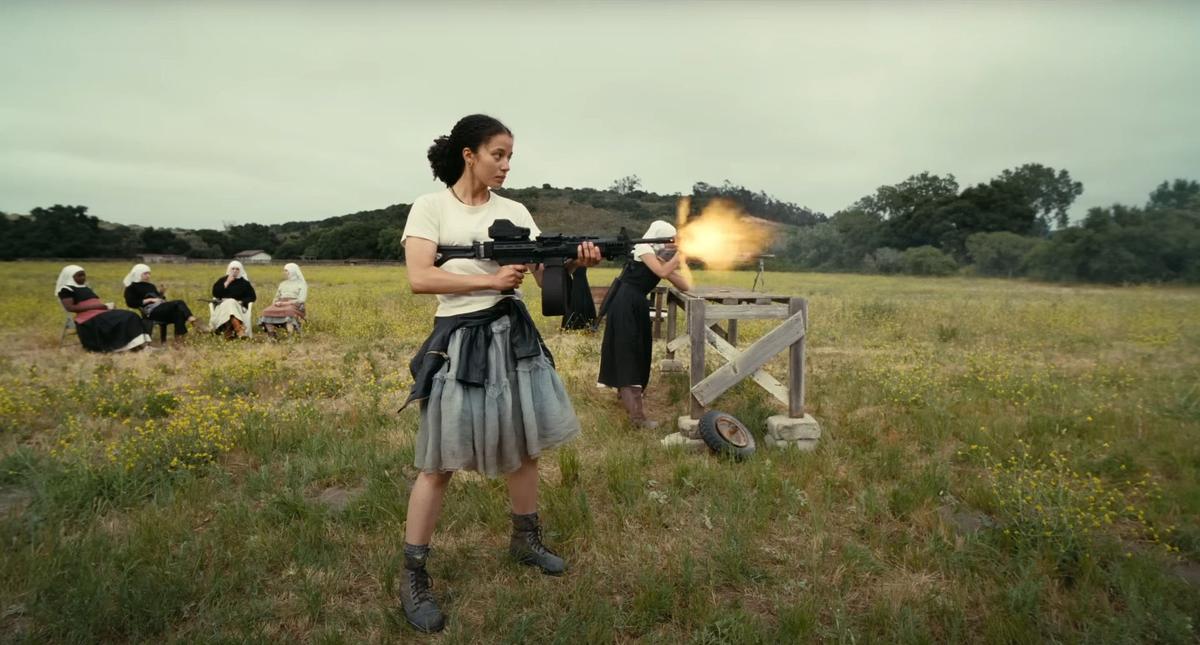[ad_1]
(Clockwise from left) Behind the scenes image of The Sisters of the Brave Beaver convent sequences from Paul Thomas Anderson’s ‘One Battle After Another’, the women of the real-life Sisters of the Valley based in Merced, California
| Photo Credit: Instagram/ @sistersofthevalley, X/ @sistersofcbd
Paul Thomas Anderson’s latest film, One Battle After Another, may be a combustible political thriller on the surface, but tucked inside its brilliant chaos is one of the most oddly grounded details in his career: a convent of pot-growing rebel nuns. Called the Sisters of the Brave Beaver, they appear as an enclave of women who’ve claimed an abandoned mission in the California hills, cultivating marijuana while sheltering rebels on the run from the authorities.

In One Battle, the Brave Beaver nuns serve as a temporary shelter for Willa (Chase Infiniti), daughter of Leonardo DiCaprio’s burned-out ex-revolutionary Bob/Ghetto Pat. But unlike many of the film’s larger-than-life flourishes, the nuns feel rooted in something tangible.

Chase Infiniti’s Willa firing an assault rifle at the Sisters of the Brave Beaver convent in a still from
| Photo Credit:
Warner Bros.
As it turns out, Anderson’s fictional convent was inspired directly by the real-life Sisters of the Valley, a group of self-described “weed nuns” based in Merced, California. Though not affiliated with any religious order, the women wear habits, follow moon cycles in their production, and speak in the language of spiritual ritual. Their mission, as they put it, is to heal the world with plant-based medicine.
On Instagram, the group posted a celebratory message after the film’s release: “Deeply honored and grateful to have been invited to be part of this masterpiece — defining film of our time. We couldn’t be prouder of its message, its legacy, and all that it represents.”
According to Variety, production designer Florencia Martin revealed that the Merced collective was a key influence when Anderson and his crew were building the Brave Beaver compound. “You don’t really see it, but they actually had a really big marijuana growing section to the convent,” Martin said. The real Sisters offered insight into how such a community might look and operate, which was not as much a cloistered sanctuary than a self-sustaining, countercultural co-op.
The convent sequences were filmed at La Purisima Mission in Lompoc, a site chosen after the filmmakers scoured the Camino Real trail in search of a location weathered enough to feel believable. “It was one of the most challenging set pieces,” Martin explained, noting that most of California’s historic missions are pristine restorations. Stripped down and isolated, La Purisima offered the right atmosphere where women could plausibly set up shop, first as a refuge, then as a business enterprise.

The Sisters of the Valley, whose CBD oils, tinctures, and salves have built them a multi-million-dollar business, provided exactly that anchor. Founded by Christine Meeusen in 2014, the collective incorporates New Age ritual, environmentalism, and biodynamic agriculture into their operations. They grow according to lunar cycles, practice vegetarianism during production, and bottle under the full moon. Members refer to each other as sisters, but they reject Christian affiliation. Business Insider once called them “the most talked-about women in the pot business,” and their notoriety hasn’t waned.
While cannabis is legal for both medicinal and recreational use in California, the laws remain a patchwork across the United States, where it is still federally classified as an illegal substance. That gray area makes groups like the Sisters of the Valley unusual. Though they openly cultivate cannabis, they focus largely on hemp-derived CBD products, which are federally permitted so long as they contain less than 0.3 percent THC (the psychoactive compound in cannabis). In practice, this allows the Merced-based collective to operate legally while embracing the symbolism of weed culture.
For Anderson, grounding his narrative in lived subcultures has long been part of the trick. He has often weaved in strands of cannabis culture from Inherent Vice to Licorice Pizza, and has been outspoken about easing stigma around cannabis use. In One Battle, that ethos is embodied by DiCaprio’s plaid bathrobe and perpetual haze of smoke, that mark him as a stoner dad whose half-faded ideals still glow faintly in every joint he lights over the course of the film.
One Battle After Another is currently running in theatres
Published – September 29, 2025 03:09 pm IST
[ad_2]
The weed nuns that inspired Paul Thomas Anderson’s ‘One Battle After Another’





